Peace movement
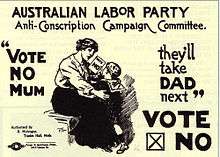
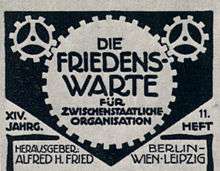
A peace movement is a social movement that seeks to achieve ideals such as the ending of a particular war (or all wars), minimize inter-human violence in a particular place or type of situation, including ban guns, and often linked to the goal of achieving world peace. Means to achieve these ends include advocacy of pacifism, non-violent resistance, diplomacy, boycotts, peace camps, moral purchasing, supporting anti-war political candidates, legislation to remove the profit from government contracts to the Military–industrial complex, banning guns, creating open government and transparency tools, direct democracy, supporting Whistleblowers who expose War-Crimes or conspiracies to create wars, demonstrations, and national political lobbying groups to create legislation. The political cooperative is an example of an organization that seeks to merge all peace movement organizations and green
Some people refer to the global loose affiliation of activists and political interests as having a shared purpose and this constituting a single movement, "the peace movement", an all encompassing "anti-war movement". Seen this way, the two are often indistinguishable and constitute a loose, responsive, event-driven collaboration between groups with motivations as diverse as humanism, environmentalism, veganism, anti-racism, anti-sexism, decentralization, hospitality, ideology, theology, and faith.
The ideal of peace

There are different ideas over what "peace" is (or should be), which results in a plurality of movements seeking diverse ideals of peace. Particularly, "anti-war" movements often have short-term goals, while peace movements advocate an ongoing life-style and proactive government policy.
It is often not clear whether a movement or a particular protest is against war in general, as in pacifism, or against one's own government's participation in a war. Indeed, some observers feel that this lack of clarity or long term continuity has represented a key part of the strategy of those seeking to end a war, e.g., the Vietnam War.
Global protests against the U.S. invasion of Iraq in early 2003 are an example of a more specific, short term and loosely affiliated single-issue "movement" —with relatively scattered ideological priorities, ranging from absolutist pacifism to Islamism and Anti-Americanism (see Human shield action to Iraq). Nonetheless, some of those who are involved in several such short term movements and build up trust relationships with others within them, do tend to eventually join more global or long-term movements.
By contrast, some elements of the global peace movement seek to guarantee health security by ending war and assuring what they see as basic human rights including the right of all people to have access to air, water, food, shelter and health care. A number of activists seek social justice in the form of equal protection under the law and equal opportunity under the law for groups that have previously been disenfranchised.
The Peace movement is primarily characterized by a belief that humans should not wage war on each other or engage in violent ethnic cleansings over language, race or natural resources or ethical conflict over religion or ideology. Long-term opponents of war preparations are primarily characterized by a belief that military power is not the equivalent of justice.
The Peace movement tends to oppose the proliferation of dangerous technologies and weapons of mass destruction, in particular nuclear weapons and biological warfare. Moreover, many object to the export of weapons including hand-held machine guns and grenades by leading economic nations to lesser developed nations. Some, like SIPRI, have voiced special concern that artificial intelligence, molecular engineering, genetics and proteomics have even more vast destructive potential. Thus there is intersection between peace movement elements and Neo-Luddites or primitivism, but also with the more mainstream technology critics such as the Green parties, Greenpeace and the ecology movement they are part of.
It is one of several movements that led to the formation of Green party political associations in many democratic countries near the end of the 20th century. The peace movement has a very strong influence in some countries' green parties, such as in Germany, perhaps reflecting that country's negative experiences with militarism in the 20th century.
History
Quakers and the Enlightenment
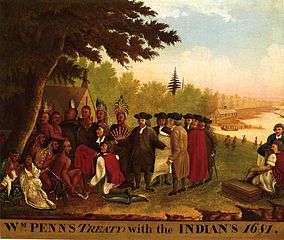
Beginning in the 16th century, the Protestant Reformation gave rise to a variety of new Christian sects, including the historic peace churches. Foremost among them were the Religious Society of Friends (Quakers), Amish, Mennonites and Church of the Brethren. The Quakers were prominent advocates of pacifism, who as early as 1660 had repudiated violence in all forms and adhered to a strictly pacifist interpretation of Christianity.[1] Throughout the many 18th century wars in which Britain participated, the Quakers maintained a principled commitment not to serve in the army and militia or even to pay the alternative £10 fine.
The first Peace movements were products of two strands of thought that coalesced at the end of the 18th century. One, rooted in the secular Enlightenment, promoted peace as the rational antidote to the world's ills, while the other was a part of the evangelical religious revival that had played an important part in the campaign for the abolition of slavery. Representatives of the former, included Jean-Jacques Rousseau, in Extrait du Projet de Paix Perpetuelle de Monsieur l'Abbe Saint-Pierre (1756),[2] Immanuel Kant, in his Thoughts on Perpetual Peace.[3] and Jeremy Bentham who proposed the formation of a peace association in 1789. Representative of the latter, was William Wilberforce who thought that strict limits should be imposed on British involvement in the French Revolutionary War based on Christian ideals of peace and brotherhood.
Peace movements
During the period of the Napoleonic Wars, although no formal peace movement was established until the end of hostilities, a significant peace movement animated by universalist ideals did emerge, due to the perception of Britain fighting in a reactionary role and the increasingly visible impact of the war on the welfare of the nation in the form of higher taxation levels and high casualty rates. Sixteen peace petitions to Parliament were signed by members of the public, anti-war and anti-Pitt demonstrations convened and peace literature was widely published and disseminated.[4]
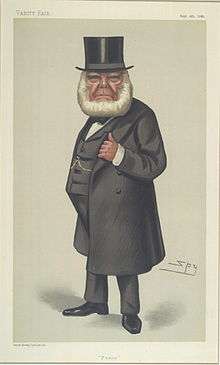
The first peace movements appeared in 1815–16. In the United States the first such movement was the New York Peace Society, founded in 1815 by the theologian David Low Dodge, and the Massachusetts Peace Society. It became an active organization, holding regular weekly meetings, and producing literature which was spread as far as Gibraltar and Malta, describing the horrors of war and advocating pacificism on Christian grounds.[5] The London Peace Society (also known as the Society for the Promotion of Permanent and Universal Peace) was formed in 1816 to promote permanent and universal peace by the philanthropist William Allen. In the 1840s, British women formed "Olive Leaf Circles", groups of around 15 to 20 women, to discuss and promote pacifist ideas.[6]
The peace movement began to grow in influence by the mid nineteenth century. The London Peace Society, under the initiative of American consul to Birmingham Elihu Burritt and the reverend Henry Richard, convened the first International Peace Congress in London in 1843.[7] The congress decided on two aims: the ideal of peaceable arbitration in the affairs of nations and the creation of an international institution to achieve that. Richard became the secretary of the Peace Society in 1850 on a full-time basis, a position which he would keep for the next 40 years, earning himself a reputation as the 'Apostle of Peace'. He helped secure one of the earliest victories for the peace movement by securing a commitment from the Great Powers in the Treaty of Paris (1856) at the end of the Crimean War, in favour of arbitration. On the European continent, wracked by social upheaval, the first peace congress was held in Brussels in 1848 followed by Paris a year later.[8]
After experiencing a recession in support due to the resurgence of militarism during the American Civil War and Crimean War, the movement began to spread across Europe and began to infiltrate the new working class socialist movements. In 1870, Randal Cremer formed the Workman's Peace Association in London. Cremer, alongside the French economist Frédéric Passy was also the founding father of the first international organisation for the arbitration of conflicts in 1889, the Inter-Parliamentary Union. The National Peace Council was founded in after the 17th Universal Peace Congress in London (July August 1908).
Nonviolent resistance
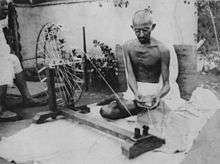
Mahatma Gandhi (1869–1948) of India was one of the most influential spokesman for peace and non-violence in the 20th century. Gandhism comprises the ideas and principles Gandhi promoted. Of central importance is nonviolent resistance. M.M. Sankhdher argues that Gandhism is not a systematic position in metaphysics or in political philosophy. Rather, it is a political creed, an economic doctrine, a religious outlook, a moral precept, and especially, a humanitarian world view. It is an effort not to systematize wisdom but to transform society and is based on an undying faith in the goodness of human nature.[9] Gandhi was strongly influenced by the pacifist ideas of Russian novelist Leo Tolstoy. In 1908 Tolstoy wrote A Letter to a Hindu, which said that only by using love as a weapon through passive resistance could the Indian people overthrow colonial rule. In 1909, Gandhi and Tolstoy began a correspondence regarding practical and theological applications of non-violence.[10] Gandhi saw himself a disciple of Tolstoy, for they agreed regarding opposition to state authority and colonialism; both hated violence and preached non-resistance. However, they differed sharply on political strategy. Gandhi called for political involvement; he was a nationalist and was prepared to use nonviolent force. He was also willing to compromise.[11]
Gandhi was the first to apply the principle of nonviolence on a large scale.[12] The concept of nonviolence (ahimsa) and nonresistance has a long history in Indian religious thought and has had many revivals in Hindu, Buddhist, Jain, Jewish and Christian contexts. Gandhi explains his philosophy and way of life in his autobiography The Story of My Experiments with Truth. Some of his other remarks were widely quoted, such as "There are many causes that I am prepared to die for but no causes that I am prepared to kill for."[13]
Gandhi realized later that this level of nonviolence required incredible faith and courage, which he believed everyone did not possess. He therefore advised that everyone need not keep to nonviolence, especially if it were used as a cover for cowardice, saying, "where there is only a choice between cowardice and violence, I would advise violence."[14][15]
Gandhi came under political fire for his criticism of those who attempted to achieve independence through more violent means. Gandhi responded, "There was a time when people listened to me because I showed them how to give fight to the British without arms when they had no arms [...] but today I am told that my non-violence can be of no avail against the [Hindu–Moslem riots] and, therefore, people should arm themselves for self-defense."[16]
Gandhi's views came under heavy criticism in Britain when it was under attack from Nazi Germany. He told the British people in 1940, "I would like you to lay down the arms you have as being useless for saving you or humanity. You will invite Herr Hitler and Signor Mussolini to take what they want of the countries you call your possessions... If these gentlemen choose to occupy your homes, you will vacate them. If they do not give you free passage out, you will allow yourselves, man, woman, and child, to be slaughtered, but you will refuse to owe allegiance to them."[17]
Challenge of World War I
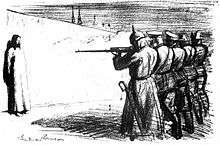
Although the onset of the First World War was generally greeted with enthusiastic patriotism across Europe, peace groups were still active in condemning the war. Many socialist groups and movements were antimilitarist, arguing that war by its nature was a type of governmental coercion of the working class for the benefit of capitalist elites.
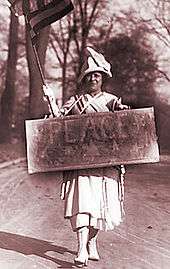
In 1915 the League of Nations Society was formed by British liberal leaders to promote a strong international organisation that could enforce the peaceful resolution of conflict. Later that year the League to Enforce Peace was established in America to promote similar goals. Hamilton Holt published an editorial in his New York City weekly magazine the Independent called "The Way to Disarm: A Practical Proposal" on September 28, 1914. It called for an international organization to agree upon the arbitration of disputes and to guarantee the territorial integrity of its members by maintaining military forces sufficient to defeat those of any non-member. The ensuing debate among prominent internationalists modified Holt's plan to align it more closely with proposals offered in Great Britain by Viscount James Bryce, a former ambassador from the UK to the US.[18] These and other initiatives were pivotal in the change in attitudes that gave birth to the League of Nations after the war.
Some of the many groups that protested against the war, as well as the traditional peace churches, were the Woman's Peace Party (which was organized in 1915 and led by noted reformer Jane Addams), the International Committee of Women for Permanent Peace (ICWPP) (also organized in 1915),[19] the American Union Against Militarism, the Fellowship of Reconciliation, and the American Friends Service Committee.[20] Jeannette Rankin, the first woman elected to Congress, was another fierce advocate of pacifism, the only person to vote no to America's entrance into both World Wars.
Interwar period
The immense loss of life during the war, for what became regarded as futile reasons, caused a sea-change in public attitudes to militarism. Organisations formed in this period included the War Resisters' International[21] the Women's International League for Peace and Freedom, the No More War Movement and the Peace Pledge Union (PPU). The League of Nations also convened several disarmament conferences in the inter-war period such as the Geneva Conference.
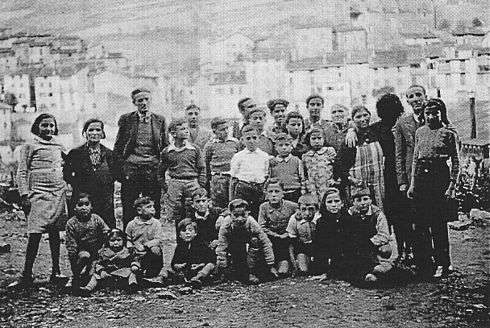
Pacifism and revulsion with war were very popular sentiments in 1920s Britain. A stream of novels and poems on the theme of the futility of war and the slaughter of the youth by old fools were published, including, Death of a Hero by Richard Aldington, Erich Remarque’s translated All Quiet on the Western Front and Beverley Nichols’s expose, Cry Havoc. A debate at the University of Oxford in 1933 on the motion 'one must fight for King and country' captured the changed mood when the motion was resoundingly defeated. Dick Sheppard established the Peace Pledge Union in 1934 totally renouncing war and aggression. The idea of collective security was also popular; instead of outright pacifism the public generally exhibited a determination to stand up to aggression, but preferably with the use of economic sanctions and multilateral negotiations.[22]
The Spanish Civil War proved a major test for international pacifism, and the work of pacifist organisations (such as War Resisters' International and the Fellowship of Reconciliation) and individuals (such as José Brocca and Amparo Poch). Shortly after the war ended, Simone Weil, despite having volunteered for service on the republican side, went on to publish The Iliad or the Poem of Force, a work that has been described as a pacifist manifesto.[23] In response to the threat of fascism, some pacifist thinkers, such as Richard B. Gregg, devised plans for a campaign of nonviolent resistance in the event of a fascist invasion or takeover.[24]
World War II
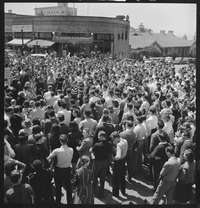
With the start of World War II, pacifist and anti-war sentiment declined in nations affected by war. Even the communist-controlled American Peace Mobilization reversed its anti-war activism once Germany invaded the Soviet Union in 1941. After the Japanese attack on Pearl Harbor, mainstream isolationist groups like the America First Committee, declined, but many smaller religious and socialist groups continued their opposition to war. Bertrand Russell argued that the necessity of defeating Adolf Hitler and the Nazis was a unique circumstance where war was not the worst of the possible evils; he called his position relative pacifism. H. G. Wells, who had joked after the armistice ending World War I that the British had suffered more from the war than they would have from submission to Germany, urged in 1941 a large-scale British offensive on the continent of Europe to combat Hitler and Nazism. Similarly Albert Einstein wrote: "I loathe all armies and any kind of violence; yet I'm firmly convinced that at present these hateful weapons offer the only effective protection."[25]
The French pacifists André and Magda Trocmé helped conceal hundreds of Jews fleeing the Nazis in the village of Le Chambon-sur-Lignon.[26][27] After the war, the Trocmés were declared Righteous Among the Nations.[26]
Pacifists in the Third Reich were dealt with harshly; German pacifist Carl von Ossietzky,[28] and Olaf Kullmann, a Norwegian pacifist active during the Nazi occupation,[29] were both imprisoned in concentration camps and died as a result of their mistreatment there. Austrian farmer Franz Jägerstätter was executed in 1943 for refusing to serve in the Wehrmacht.[30]
There were conscientious objectors and war tax resisters in both World War I and World War II. The United States government allowed sincere objectors to serve in noncombatant military roles. However, those draft resisters who refused any cooperation with the war effort often spent much of each war in federal prisons. During World War II, pacifist leaders like Dorothy Day and Ammon Hennacy of the Catholic Worker Movement urged young Americans not to enlist in military service.
Since World War II, the peace movement has become widespread throughout the world, and its previously radical doctrines are now a part of mainstream political discourse.
Anti-nuclear movement

Peace movements emerged in Japan and in 1954 they converged to form a unified "Japanese Council Against Atomic and Hydrogen Bombs". Japanese opposition to the Pacific nuclear weapons tests was widespread, and "an estimated 35 million signatures were collected on petitions calling for bans on nuclear weapons".[31]
In the United Kingdom, the Campaign for Nuclear Disarmament held an inaugural public meeting at Central Hall, Westminster, on 17 February 1958, attended by five thousand people. After the meeting a few hundred left to demonstrate at Downing Street.[32][33]
CND's declared policies were the unconditional renunciation of the use, production of or dependence upon nuclear weapons by Britain and the bringing about of a general disarmament convention. In the meantime, Britain should halt the flight of planes armed with nuclear weapons, end nuclear testing, not proceed with missile bases and not provide nuclear weapons to any other country.
The first Aldermaston March was organised by the CND and took place at Easter 1958, when several thousand people marched for four days from Trafalgar Square, London, to the Atomic Weapons Research Establishment close to Aldermaston in Berkshire, England, to demonstrate their opposition to nuclear weapons.[34][35] The Aldermaston marches continued into the late 1960s when tens of thousands of people took part in the four-day marches.[31] The formation of CND tapped widespread popular fear and opposition to nuclear weapons following the development of the first hydrogen bomb, and in the late 1950s and early 1960s anti-nuclear marches attracted large followings, especially to the annual Aldermaston march at Easter.
Popular opposition to nuclear weapons produced a Labour Party resolution for unilateral nuclear disarmament at the 1960 Party Conference, but it was overturned the following year and did not appear on later agendas. This experience disillusioned many anti-nuclear protesters with the Labour Party, in whom they had previously put their hopes. Subsequently there was a strong anti-parliamentary current in the British peace movement, and it has been argued that during the 1960s anarchism became as influential as socialism.
Two years after the formation of CND Bertrand Russell, its president, resigned to form the Committee of 100, which was to undertake civil disobedience in the form of sit-down demonstrations in central London and at nuclear bases around the UK. Russell said that these were needed because the press had grown indifferent to CND and because large-scale direct action could force the government to change its policy.[36] A hundred prominent people, many in the arts, put their names to the organisation. Very large numbers of demonstrators were essential to this strategy, but the violence of the police, the arrest and imprisonment of demonstrators, and pre-emptive arrests for conspiracy made support dwindle rapidly. Although several eminent people took part in sit-down demonstrations (including Russell, whose imprisonment at the age of 89 was widely reported) many of the 100 signatories were inactive.[37]
As the Committee of 100 had a non-hierarchical structure and no formal membership, many local groups sprang up calling themselves Committee of 100. This helped the promulgation of civil disobedience but it produced policy confusion and, as the decade progressed, Committee of 100 groups engaged in actions on many social issues not directly related to war and peace.
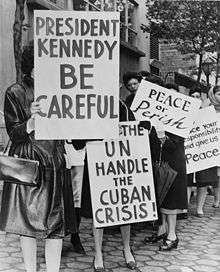
In the United States, in 1961, at the height of the Cold War, about 50,000 women brought together by Women Strike for Peace marched in 60 cities in the United States to demonstrate against nuclear weapons. It was the largest national women's peace protest of the 20th century.[38][39]
In 1958, Linus Pauling and his wife presented the United Nations with the petition signed by more than 11,000 scientists calling for an end to nuclear-weapon testing. The "Baby Tooth Survey," headed by Dr Louise Reiss, demonstrated conclusively in 1961 that above-ground nuclear testing posed significant public health risks in the form of radioactive fallout spread primarily via milk from cows that had ingested contaminated grass.[40][41][42] Public pressure and the research results subsequently led to a moratorium on above-ground nuclear weapons testing, followed by the Partial Test Ban Treaty, signed in 1963 by John F. Kennedy, Nikita Khrushchev and Harold Macmillan.[43] On the day that the treaty went into force, the Nobel Prize Committee awarded Pauling the Nobel Peace Prize, describing him as "Linus Carl Pauling, who ever since 1946 has campaigned ceaselessly, not only against nuclear weapons tests, not only against the spread of these armaments, not only against their very use, but against all warfare as a means of solving international conflicts."[44][45] Pauling started the International League of Humanists in 1974. He was president of the scientific advisory board of the World Union for Protection of Life and also one of the signatories of the Dubrovnik-Philadelphia Statement.
On June 12, 1982, one million people demonstrated in New York City's Central Park against nuclear weapons and for an end to the cold war arms race. It was the largest anti-nuclear protest and the largest political demonstration in American history.[46][47] International Day of Nuclear Disarmament protests were held on June 20, 1983 at 50 sites across the United States.[48][49] In 1986, hundreds of people walked from Los Angeles to Washington DC in the Great Peace March for Global Nuclear Disarmament.[50] There were many Nevada Desert Experience protests and peace camps at the Nevada Test Site during the 1980s and 1990s.[51][52]
On May 1, 2005, 40,000 anti-nuclear/anti-war protesters marched past the United Nations in New York, 60 years after the atomic bombings of Hiroshima and Nagasaki.[53] This was the largest anti-nuclear rally in the U.S. for several decades.[54] In Britain, there were many protests about the government's proposal to replace the aging Trident weapons system with a newer model. The largest protest had 100,000 participants and, according to polls, 59 percent of the public opposed the move.[54]
The International Conference on Nuclear Disarmament took place in Oslo in February 2008, and was organized by The Government of Norway, the Nuclear Threat Initiative and the Hoover Institute. The Conference was entitled Achieving the Vision of a World Free of Nuclear Weapons and had the purpose of building consensus between nuclear weapon states and non-nuclear weapon states in relation to the Nuclear Non-proliferation Treaty.[55]
In May 2010, some 25,000 people, including members of peace organizations and 1945 atomic bomb survivors, marched for about two kilometers from downtown New York to the United Nations headquarters, calling for the elimination of nuclear weapons.[56]
Vietnam War Protests

The peace movement began in the 1960s in the United States in opposition to U.S. involvement in the Vietnam War. Some advocates within this movement advocated a unilateral withdrawal of U.S. forces from South Vietnam.
The first U.S. anti-Vietnam protest was led in 1962 by Sam Marcy, founder of Workers World Party, a demonstration whose importance was noted by Ho Chi Minh in an interview published in the National Guardian newspaper.
Opposition to the Vietnam War tended to unite groups opposed to U.S. anti-communism, imperialism and colonialism and, for those involved with the New Left, capitalism itself, such as the Catholic Worker Movement. Others, such as Stephen Spiro opposed the war based on the theory of Just War.
In 1965 the movement began to gain national prominence. Provocative actions by police and by protesters turned anti-war demonstrations in Chicago at the 1968 Democratic National Convention into a riot. Explosive news reports of American military abuses, such as the 1968 My Lai Massacre, brought new attention and support to the anti-war movement bringing it to its height. The movement continued to prosper over the span of the conflict.
High-profile opposition to the Vietnam war turned to street protests in an effort to turn U.S. political opinion against the war. The protests gained momentum from the Civil Rights Movement that had organized to oppose segregation laws, which had laid a foundation of theory and infrastructure on which the anti-war movement grew. Protests were fueled by a growing network of independently published newspapers (known as "underground papers") and the timely advent of large venue rock'n'roll festivals such as Woodstock and Grateful Dead shows, attracting younger people in search of generational togetherness. The movement progressed from college campuses to middle-class suburbs, government institutions, and labor unions.
Peace movements by country
Canada
Agnes Macphail, a Canadian pacifist, was the first woman to be elected to the Canadian House of Commons. Macphail objected to the Royal Military College of Canada in 1931 on pacific grounds.[57] Macphail was also the first Canadian woman delegate to the League of Nations, where she worked with the World Disarmament Committee. Although a pacifist, she voted for Canada to enter World War II.
The Canadian Peace Congress (1949–1990) was a leading organizer in the peace movement for many years, particularly when it was under the leadership of James Gareth Endicott who was its president until 1971.
Currently, Canada has a diverse peace movement, with coalitions and networks in many cities, towns and regions. The largest cross-country umbrella coalition is the Canadian Peace Alliance, whose 140 member groups include large city-based coalitions, small grassroots groups, national and local unions, faith, environmental, and student groups, with a combined membership of over 4 million Canadians. The Canadian Peace Alliance has been a leading voice, along with its member groups opposing the "War on Terror". In particular, the CPA opposes Canada's participation in the war in Afghanistan and Canadian complicity in what it views as misguided and destructive U.S. foreign policy.
Canada has also been home to a growing movement of Palestinian solidarity, marked by an increasing number of grassroots Jewish groups opposed to Israel's policies, in many cases likening them to Apartheid, war crimes, and ethnic cleansing.
Germany
During the Cold War (1947–89), the West German peace movement concentrated on the abolition of nuclear technology, particularly weapons, from West Germany and Europe. Most activists stridently attacked both the United States and Soviet Union. Conservative critics repeatedly warned it was infiltrated by agents from the East German secret police, the Stasi.[58]
After 1989, the cause of peace was espoused by Green parties across Europe. It sometimes exercised significant influence over policy, e.g., as during 2002 when the German Greens influenced German Chancellor Gerhard Schröder to oppose involvement in Iraq. The Greens controlled of the German Foreign Ministry under Joschka Fischer (a Green and the single most popular politician in Germany at the time). Fischer sought to limit German involvement in the War on Terrorism; he joined with French President Jacques Chirac whose opposition in the UN Security Council was decisive in limiting support for the U.S. plan to invade Iraq.
Israel
The Israeli–Palestinian conflict and Arab–Israeli conflict have existed since the inception of Zionism, and especially since the 1948 formation of the state of Israel, and the 1967 occupation of Palestinian and other Arab lands. The mainstream peace movement in Israel is Peace Now (Shalom Akhshav), whose supporters tend to vote for the Labour Party or Meretz.
Peace Now was founded in the aftermath of Egyptian President Anwar Sadat's historic visit to Jerusalem, when many people felt that the chance for peace might be missed. PM Begin acknowledged that the Peace Now rally in Tel Aviv at the eve of his departure for the Camp David Summit with Presidents Sadat and Carter—drawing a crowd of 100,000, the largest peace rally in Israel until then—had a part in his decision to withdraw from Sinai and dismantle Israeli settlements there. Peace Now supported Begin for a time, and hailed him as a peace-maker, but turned against him when withdrawal from Sinai was accompanied by an accelerated campaign of land confiscation and settlement building in the West Bank.

Peace Now advocates a negotiated peace with the Palestinians. Originally this was worded vaguely, with no definition of who "the Palestinians" are and who represents them. Peace Now was quite tardy in joining the dialogue with the PLO, started by such groups as the Israeli Council for Israeli-Palestinian Peace and the Hadash communist party. Only in 1988 did Peace Now accept that the PLO is the body regarded by the Palestinians themselves as their representative.
During the first Intifada, Peace Now held numerous protests and rallies to protest the army's cruelty and call for a negotiated withdrawal from the Occupied Territories. At the time Peace Now strongly targeted then for Defence Minister Yitzhak Rabin for his infamous order to "break the bones of Palestinian trouble-makers". However, after Rabin became Prime Minister, signed the Oslo Agreement and shook Yasser Arafat's hand on the White House lawn, Peace Now strongly supported him and mobilized public support for him against the settlers' increasingly vicious attacks. Peace Now had a central role in the November 4, 1995 rally after which Rabin was assassinated by Yigal Amir, an extreme-right militant.
Since then the annual Rabin memorial rallies, held every year at the beginning of November, have become the main event of the Israeli Peace Movement, always certain to draw a crowd in the tens or hundreds of thousands. While officially organized by the Rabin Family Foundation, Peace Now presence in these annual rallies is always conspicuous.
Nowadays, Peace Now is especially known for its struggle against the expansion of settlement outposts on the West Bank.
Gush Shalom, the Israeli Peace Bloc, is a radical movement to the left of Peace Now. In its present name and structure, Gush Shalom grew out of the Jewish-Arab Committee Against Deportations, which protested the deportation without trial of 415 Palestinian Islamic activists to Lebanon in December 1992, and erected a protest tent in front of the prime minister's office in Jerusalem for two months—until the government consented to let the deportees return. Members then decided to continue as a general peace movement with a program strongly opposing the occupation and advocating the creation of an independent Palestine side-by-side with Israel in its pre-1967 borders ("The Green Line") and with an undivided Jerusalem serving as the capital of both states.
While existing under the name Gush Shalom only since 1992, this movement is in fact the lineal descendant of various groups, movements and action committees that espoused much the same program since 1967, and that occupied the same space on the political scene. In particular, Gush Shalom is the descendant of the Israeli Council for Israeli-Palestinian Peace (ICIPP), which was founded in 1975. The ICIPP founders included: a group of dissidents from the Israeli establishment, among them were Major-General Mattityahu Peled, who was member of the IDF General Staff during the 1967 Six Day War and after being dishcarged from the army in 1969 turned increasingly in the direction of peace; Dr. Ya'akov Arnon, a well-known economist who headed the Zionist Federation in the Netherlands before coming to Israel in 1948, and was for many years director-general of the Israeli Ministry of Finance and afterwards chaired the Board of Directors of the Israeli Electricity Company; and Aryeh Eliav, who was secretary-general of the Labour Party until he broke with the then PM Golda Meir over the issue of whether or not a Palestinian People existed and had national rights.
These three and some two hundred more people became radicalised and came to the conclusion that arrogance was a threat to Israel's future and that dialogue with the Palestinians must be opened. They came together with a group of younger, grassroots peace activists who had been active against the occupation since 1967. The bridge between the two groups was Uri Avnery, a well known muckraking journalist who had been member of the Knesset (Israeli Parliament) between 1965 and 1973, at the head of his own radical one-man party.
The main achievement of the ICIPP was the opening of dialogue with the Palestine Liberation Organization (PLO), with the aim of making Israelis understand the need of talking and reaching a peace deal with the Palestinians, and conversely making Palestinians aware of the need to talk to and eventually reach a deal with Israel.
At present, Gush Shalom activists are mainly involved in daily struggle at Palestinian West Bank villages that have their land confiscated by the Separation barrier, erected to stop suicide bombers. Gush activists are to be found, together with those of other Israeli movements like Ta'ayush and Anarchists Against the Wall, joining the Palestinian villagers of Bil'in in the weekly non-violent protest marches held to protest confiscation of more than half of the village lands.
Although Gush Shalom earned itself respect among peace-seeking Israelis as well as in the United States and Europe, it is regarded by mainstream Israelis as a purely pro-Palestinian movement.
United Kingdom
From 1934 the Peace Pledge Union gained many adherents to its pledge, "I renounce war and will never support or sanction another." Its support diminished considerably with the outbreak of war in 1939, but it remained the focus of pacifism in the post-war years.
Post–World War II peace-movement efforts in the United Kingdom were initially focused on the dissolution of the British Empire and the rejection of imperialism by the United States and Union of Soviet Socialist Republics. The anti-nuclear movement sought to "opt out" of the Cold War and rejected such ideas as "Britain's Little Independent Nuclear Deterrent" in part on the grounds that it (BLIND) was in contradiction even with MAD.
The VSC (Vietnam Solidarity Campaign) led by Tariq Ali mounted several very large and violent demonstrations against the Vietnam war in 67/68 but the first anti Vietnam demonstration was at the American Embassy in London and took place in 1965.[59]
The peace movement was later associated with the Peace camp movement as Labour moved "more to the centre" under Prime Minister Tony Blair. By early 2003, the peace and anti-war movement, mostly grouped together under the banner of the Stop the War Coalition, was powerful enough to cause several of Blair's cabinet to resign, and hundreds of Labour Party MPs to vote against their government. Blair's motion to support militarily the U.S. plan to invade Iraq continued only due to support from the UK Conservative Party. Protests against the invasion of Iraq were particularly vocal in Britain. Polls suggested that without UN Security Council approval, the UK public was very much opposed to involvement, and over two million people protested in Hyde Park (the previous largest demonstration in the UK having had around 600,000).
The peace movement has seen 'pop-up' newspapers, pirate radio stations and plays over the years. The UK had its first permanent national press newspaper with strong and consistent anti-war, pro peace movement themes in 2012.[60] The presence of national media backing of the peace movement helped the newspaper grow to a monthly readership of almost 4 million without any financial investment or backing by 2015.[61]
The primary function of the National Peace Congress was to provide opportunities for consultation and joint activities between its affiliated members, to help create an informed public opinion on the issues of the day and to convey to the government of the day the views of the substantial section of British life represented by its affiliated membership. The NPC folded in 2000 to be replaced in 2001 by Network for Peace, which was set up to continue the networking role of NPC.
United States
During the tail end of the Cold War, U.S. peace activists largely concentrated on slowing the superpower arms race in the belief that this would reduce the possibility of nuclear war between the U.S. and the USSR. As the Reagan administration accelerated military spending and adopted a tough, challenging stance to the Russians, peace groups such as the Nuclear Freeze and Beyond War sought to educate the public on the what they believed was the inherent riskiness and ruinous cost of this policy. Outreach to individual citizens in the Soviet Union and mass meetings, using then-new satellite link technology, were part of peacemaking activities in the 1980s. In 1981, Thomas started the longest uninterrupted peace vigil in U.S. history.[62] He was later joined at Lafayette Square by anti-nuclear activists Concepcion Picciotto and Ellen Thomas.[63]
In response to Iraq's invasion of Kuwait in 1990, President George H. W. Bush began preparations for a mideast war. Peace activists were starting to find their groove just before the Gulf War was launched in February 1991, with well-attended rallies, especially on the west coast. However, the ground war was over in less than a week. A lopsided Allied victory and a media-incited wave of patriotic sentiment washed over the protest movement before it could develop traction.
During the 1990s, peacemakers' priorities included seeking a solution to the Israeli–Palestinian impasse, belated efforts at humanitarian assistance to war-torn regions such as Bosnia and Rwanda, and Iraq; American peace activists brought medicine into Iraq in defiance of U.S. law, in some cases enduring heavy fines and imprisonment in retaliation. Some of the principal groups involved were Voices in the Wilderness and the Fellowship of Reconciliation.
Before, during, and after the War in Iraq began, a concerted protest effort began in the United States. On February 15, 2003 a series of protests across the globe took place with events in approximately 800 cities. In March 2003, just before the U.S. and British Military led invasion of Iraq, a protest mobilization called "The World Says No to War" led to as many as 500,000 protestors in cities across the U.S. However, many protest organizations have persisted as the United States has maintained a military and corporate presence in Iraq.
U.S. activist groups including United for Peace and Justice, Code Pink (Women Say No To War), Iraq Veterans Against the War, Military Families Speak Out (MFSO), Not In Our Name, A.N.S.W.E.R., Veterans for Peace, and The World Can't Wait continued to protest against the Iraq War. Methods of protest include rallies and marches, impeachment petitions, the staging of a war-crimes tribunal in New York (to investigate crimes and alleged abuses of power of the Bush administration), bringing Iraqi women to tour the U.S. and tell their side of the story, street theater and independent filmmaking, high-profile appearances by anti-war activists such as Scott Ritter, Janis Karpinski, and Dahr Jamail, resisting military recruiting on college campuses, withholding tax monies, mass letter-writing to legislators and newspapers, blogging, music, and guerrilla theater. Independent media producers continue to broadcast, podcast and Web-host programs about the movement against the Iraq War.
Starting in 2005, opposition to military action against Iran started in the United States, the United Kingdom and elsewhere, including the creation of the Campaign Against Sanctions and Military Intervention in Iran. By August 2007, fears of an imminent United States and/or Israeli attack on Iran had increased to the level that several Nobel Prize winners, Shirin Ebadi (Nobel Peace Prize 2003), Mairead Corrigan-Maguire and Betty Williams (joint Nobel Peace Prize 1976), Harold Pinter (Nobel Prize for Literature 2005) and Jody Williams (Nobel Peace Prize 1997), along with several anti-war groups, including The Israeli Committee for a Middle East Free from Atomic, Biological and Chemical Weapons, Campaign for Nuclear Disarmament, CASMII, Code Pink and many others, warned about what they believed was the imminent risk of a "war of an unprecedented scale, this time against Iran", especially expressing concern that an attack on Iran using nuclear weapons had "not been ruled out". They called for "the dispute about Iran's nuclear program, to be resolved through peaceful means" and a call for Israel, "as the only Middle Eastern state suspected of possession of nuclear weapons", to join the Nuclear Non-Proliferation Treaty.[64]
See also
- Category:Peace movements
- Category:Peace
- Category:Peace organizations
- Category:Peace awards
- Category:Anti-war
- Category:Anti-war protests
- Category:Anti-nuclear movement
- American Friends Service Committee
- Conscientious objector
- Conscientious objection throughout the world
- Global citizens movement
- International Campaign to Abolish Nuclear Weapons
- List of anti-war organizations
- List of peace activists
- Mohandas Gandhi
- Nuclear-free zone
- Peace
- Peace Organisation of Australia
- Peace Pledge Union
- Peace symbol
- Peace flag
- Peace walk
- War resister
- White Rose
- World peace
- World Peace Marathon
References
- ↑ Eric Roberts. "Quaker Traditions of Pacifism and Nonviolence". Stanford University.
- ↑ Hinsley, pp. 46-61.
- ↑ Hinsley, pp.62-80.
- ↑ Ceadel, Martin (1996). The Origins of War Prevention: The British Peace Movement and International Relations, 1730–1854. Oxford University Press,. Retrieved 2013-02-07.
- ↑ Pacifism to 1914 : an overview by Peter Brock. Toronto, Thistle Printing, 1994. (pp. 38-9).
- ↑ The Long Road to Greenham : Feminism and Anti-Militarism in Britain since 1820, by Jill Liddington. London, Virago, 1989 ISBN 0-86068-688-4 (pp. 14-5).
- ↑ Cortright, David (2008). Peace: A History of Movements and Ideas. Cambridge University Press. Retrieved 2013-02-07.
- ↑ André Durand. "Gustave Moynier and the peace societies". International Committee of the Red Cross.
- ↑ M.M. Sankhdher, "Gandhism: A Political Interpretation", Gandhi Marg (1972) pp. 68–74
- ↑ Murthy, B. Srinivasa, ed. (1987). Mahatma Gandhi and Leo Tolstoy: Letters (PDF). Long Beach, California: Long Beach Publications. ISBN 0-941910-03-2. Retrieved 14 January 2012.
- ↑ Green, Martin Burgess (1986). The origins of nonviolence: Tolstoy and Gandhi in their historical settings. Pennsylvania State University Press. ISBN 978-0-271-00414-3. Retrieved 17 January 2012.
- ↑ Asirvatham, Eddy. Political Theory. S.chand. ISBN 81-219-0346-7.
- ↑ James Geary, Geary's Guide to the World's Great Aphorists (2007) p. 87
- ↑ William Borman (1986). Gandhi and non-violence. SUNY Press. p. 253.
- ↑ Faisal Devji, The Impossible Indian: Gandhi and the Temptation of Violence (Harvard University Press; 2012)
- ↑ reprinted in Louis Fischer, ed. The Essential Gandhi: An Anthology of His Writings on His Life, Work, and Ideas 2002 (reprint edition) p. 311.
- ↑ Stanley Wolpert (2002). Gandhi's passion: the life and legacy of Mahatma Gandhi. Oxford University Press. p. 197.
- ↑ Herman, 56-7
- ↑ Pacifism vs. Patriotism in Women's Organizations in the 1920s.
- ↑ Chatfield, Charles, “Encyclopedia of American Foreign Policy” 2002.
- ↑ Radical Pacifism: The War Resisters League and Gandhian Nonviolence in America, 1915–1963 by Scott H. Bennett. New York, Syracuse University Press, 2003, ISBN 0-8156-3028-X, p.18.
- ↑ "Pacifism". University of Wellington.
- ↑ "War and the Iliad". The New York Review of books. Retrieved 29 September 2009.
- ↑ Lynd, Staughton. Nonviolence in America: a documentary history,Bobbs-Merrill, 1966, (pps. 271-296).
- ↑ Quoted on Albert Einstein at Peace Pledge Union, and but also discussed in detail in articles in Einstein, Albert (1954), Ideas and Opinions, New York: Random House, ISBN 0-517-00393-7
- 1 2 Lest Innocent Blood Be Shed: The Story of Le Chambon and How Goodness Happened There Philip P. Hallie, (1979) New York: Harper & Row, ISBN 0-06-011701-X
- ↑ Brock and Young, p. 220.
- ↑ Brock and Young, p.99.
- ↑ Brock and Socknat, pp. 402-3.
- ↑ In Solitary Witness: The Life and Death of Franz Jägerstätter by Gordon Zahn. Springfield, Illinois: Templegate Publishers. ISBN 0-87243-141-X.
- 1 2 Jim Falk (1982). Global Fission: The Battle Over Nuclear Power, Oxford University Press, pp. 96-97.
- ↑ John Minnion and Philip Bolsover (eds.) The CND Story, Alison and Busby, 1983, ISBN 0-85031-487-9
- ↑ "Campaign for Nuclear Disarmament (CND)". Spartacus.schoolnet.co.uk. Retrieved 2011-01-09.
- ↑ A brief history of CND
- ↑ "Early defections in march to Aldermaston". Guardian Unlimited. 1958-04-05.
- ↑ Bertrand Russell, "Civil Disobedience", New Statesman, 17 February 1961
- ↑ Frank E. Myers, "Civil Disobedience and Organizational Change: The British Committee of 100", Political Science Quarterly, Vol. 86, No. 1. (Mar., 1971), pp. 92–112
- ↑ Woo, Elaine (January 30, 2011). "Dagmar Wilson dies at 94; organizer of women's disarmament protesters". Los Angeles Times.
- ↑ Hevesi, Dennis (January 23, 2011). "Dagmar Wilson, Anti-Nuclear Leader, Dies at 94". The New York Times.
- ↑ Louise Zibold Reiss (November 24, 1961). "Strontium-90 Absorption by Deciduous Teeth: Analysis of teeth provides a practicable method of monitoring strontium-90 uptake by human populations" (PDF). Science. Retrieved October 13, 2009.
- ↑ Thomas Hager (November 29, 2007). "Strontium-90". Oregon State University Libraries Special Collections. Retrieved December 13, 2007.
- ↑ Thomas Hager (November 29, 2007). "The Right to Petition". Oregon State University Libraries Special Collections. Retrieved December 13, 2007.
- ↑ Jim Falk (1982). Global Fission: The Battle Over Nuclear Power, Oxford University Press, p. 98.
- ↑ Linus Pauling (October 10, 1963). "Notes by Linus Pauling. October 10, 1963.". Oregon State University Libraries Special Collections. Retrieved December 13, 2007.
- ↑ Jerry Brown and Rinaldo Brutoco (1997). Profiles in Power: The Anti-nuclear Movement and the Dawn of the Solar Age, Twayne Publishers, pp. 191-192.
- ↑ Jonathan Schell. The Spirit of June 12 The Nation, July 2, 2007.
- ↑ 1982 - a million people march in New York City
- ↑ Harvey Klehr. Far Left of Center: The American Radical Left Today Transaction Publishers, 1988, p. 150.
- ↑ 1,400 Anti-nuclear protesters arrested Miami Herald, June 21, 1983.
- ↑ Hundreds of Marchers Hit Washington in Finale of Nationwaide Peace March Gainesville Sun, November 16, 1986.
- ↑ Robert Lindsey. 438 Protesters are Arrested at Nevada Nuclear Test Site New York Times, February 6, 1987.
- ↑ 493 Arrested at Nevada Nuclear Test Site New York Times, April 20, 1992.
- ↑ Anti-Nuke Protests in New York Fox News, May 2, 2005.
- 1 2 Lawrence S. Wittner. A rebirth of the anti-nuclear weapons movement? Portents of an anti-nuclear upsurge Bulletin of the Atomic Scientists, 7 December 2007.
- ↑ "International Conference on Nuclear Disarmament". February 2008.
- ↑ A-bomb survivors join 25,000-strong anti-nuclear march through New York Mainichi Daily News, May 4, 2010.
- ↑ Preston `Canada`s RMC: A History of the Royal Military College` (University of Toronto Press, Toronto, 1969)
- ↑ Wilfried von Bredow, "The Peace Movement in the Federal Republic of Germany," Armed Forces & Society (1982) 9#1 pp 33-48
- ↑ Comment Magazine. (Communist) http://www.library.law.ua.edu/spcoll/findaids/murpaid/murpaid4.htm
- ↑ "Typical Peace-Movement Article". The International Press & Media Group. Retrieved 2015-09-27.
- ↑ "ABC Verified Circulation". Retrieved 2015-09-15.
- ↑ Colman McCarthy (February 8, 2009). "From Lafayette Square Lookout, He Made His War Protest Permanent". The Washington Post.
- ↑ The Oracles of Pennsylvania Avenue
- ↑ "For a Middle East free of all Weapons of Mass Destruction". Campaign Against Sanctions and Military Intervention in Iran. 2007-08-06. Retrieved 2007-11-03.
Further reading
- Scott H. Bennett, Radical Pacifism: The War Resisters League and Gandhian Nonviolence in America, 1915–45 (Syracuse Univ. Press, 2003).
- Charles Chatfield, editor, Peace Movements in America (New York: Schocken Books, 1973). ISBN 0-8052-0386-9
- Charles Chatfield with Robert Kleidman, The American Peace Movement: Ideals and Activism (New York: Twayne Publishers, 1992). ISBN 0-8057-3852-5
- Eastman, Carolyn, "Fight Like a Man: Gender and Rhetoric in the Early Nineteenth-Century American Peace Movement", American Nineteenth Century History 10 (Sept. 2009), 247–71.
- Elsie Locke, Peace People: A History of Peace Activities in New Zealand (Christchurch, NZ: Hazard Press, 1992). ISBN 0-908790-20-1
- Sam Marullo and John Lofland, editors, Peace Action in the Eighties: Social Science Perspectives (New Brunswick: Rutgers University Press, 1990). ISBN 0-8135-1561-0
- Caroline Moorehead, Troublesome People: The Warriors of Pacifism (Bethesda, MD: Adler & Adler, 1987).
- Roger C. Peace III, A Just and Lasting Peace: The U.S. Peace Movement from the Cold War to Desert Storm (Chicago: The Noble Press, 1991). ISBN 0-9622683-8-0
- Lawrence S. Wittner, Rebels Against War: The American Peace Movement, 1933–1983 (Philadelphia: Temple University Press, 1984). ISBN 0-87722-342-4
- Nancy Zaroulis and Gerald Sullivan, Who Spoke Up? American Protest Against the War in Vietnam, 1963–1975 (New York: Holt, Rinehart and Winston, 1984). ISBN 0-03-005603-9
- André Durand: "Gustave Moynier and the peace societies". In: International Review of the Red Cross, no. 314, p. 532–550 (31-10-1996)
Primary sources
- Stellato, Jesse, ed. Not in Our Name: American Antiwar Speeches, 1846 to the Present (Pennsylvania State University Press, 2012). 287 pp

